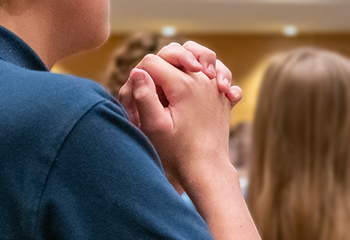
This material is from the Catholic News Service article “During plague, Catholic Church called on saints for help, healing” by Carol Zimmerman and is used with permission.
The Catholic Church has had a long tradition of calling on saints and praying for their intercession in sickness and difficult times.
This plea for saintly help for protection from disease and healing was particularly evident when the bubonic plague, or Black Death, spread throughout Europe in the 14th century killing one-third of the population.
At the time, in many cities and villages where medical knowledge was limited, cities and villages often adopted a plague saint to protect them.
In Florence, Italy, the bishop had an altar built in honor of St. Sebastian as a means to stop the Black Death and after the plague was over, he built a church dedicated to the saint in thanksgiving for his intercession.
Artwork depicting the plague shows that St. Sebastian seemed to be the go-to saint at the time.
He was martyred around the year 288 during the reign of the Roman emperor Diocletian. He was shot by arrows, which is how he is portrayed in paintings where the arrows are also said to be symbolic of the arrows of the Black Death.
But the special appeal of St. Sebastian has a lot of layers. He is said to have converted to Christianity after seeing the bravery of Christian martyrs and he then drew others to become Christian, including a Roman officer who was said to have been cured of a plague at his conversion.
This particular action caught the attention of Diocletian, who sentenced St. Sebastian to death by arrows. But the saint, according to tradition, is said to have survived the arrows and returned to Diocletian to have strong words with him, which caused the emperor to again, and successfully this time, have St. Sebastian executed.
The saint’s prayers for the Roman soldier and the soldier’s cure made him associated with the cure of plagues, especially in Italy.
St. Roch also is portrayed in paintings of the plague, but he is shown among victims, often praying to Mary, since he too was a victim of the disease. The same holds true for St. Aloysius Gonzaga, who contracted a different plague, which hit Rome in 1591, and died of it after catching the disease while caring for victims.
There also is a whole group of saints who were called on for prayers during the plague, starting in 1348 in Munich. This group goes by the name the Fourteen Holy Helpers.
The group of 14 — each with individual feast days and initially one day for the whole group until 1969 — is honored in a German chapel that is a pilgrimage site. There also are churches in Italy, Austria, Hungary and other European countries named after these 14 and one parish in West Seneca, New York, in the Diocese of Buffalo.
Twelve of this specialized group are martyrs and three are women. Perhaps most known now among the group is St. Blaise, patron saint of throats, who is invoked each Feb. 3 on his feast day, for blessing of the throats.
The names of the other 13 — and what people pray to them for protection from or intercession for — follow: St. Achatius, headaches; St. Barbara, fever or sudden death; St. Catherine of Alexandria, sudden death; St. Christopher, plagues, sudden death; St. Cyriacus (Cyriac), temptations; St. Denis (Dionysius), headaches; St. Erasmus (Elmo), abdominal maladies; St. Eustachius (Eustace), family trouble; St. George, protection of domestic animals; St. Giles (Aegidius), plagues, good confession; St. Margaret of Antioch, safe childbirth; St. Pantaleone, physicians; St. Vitus (St. Guy), epilepsy.
During this current time of coronavirus pandemic, some have called on St. Corona as a possible patron, but the connection seems to be in name only. Little is known about this young woman who was killed for her Christian faith, presumably in the second century A.D.
St. Corona also is not the namesake for the virus. The Latin word “corona” means “crown,” an indication that the young saint had achieved the “crown of eternal life” because of the steadfastness of her faith. The connection with the coronaviruses, named because of their crown-like structure, is just a coincidence.
Over the centuries, St. Corona was often prayed to by people seeking her help in times of trouble, be it heavy storms or livestock diseases.
People believed she had a positive influence regarding money matters since “coronae” (crowns) was the name given to coins. As a result, treasure-hunters often invoked her name and in light of how COVID-19 has triggered an economic crisis, she could be called on again.
Among the saints, there are many who can be invoked for protection or healing of nearly every possible ailment from eye troubles, headaches and toothaches to cancer, rabies and epilepsy.




